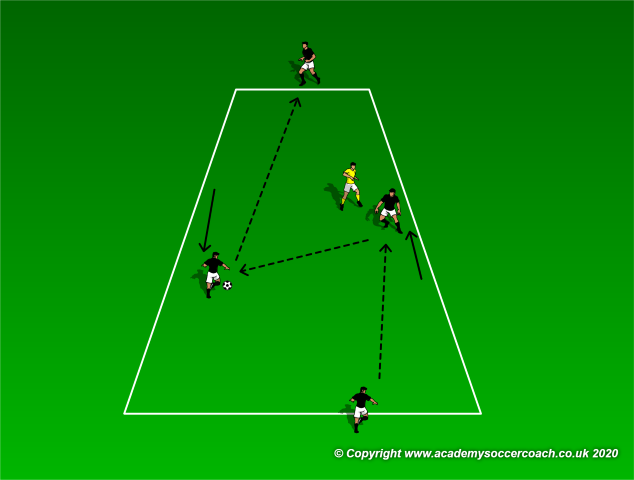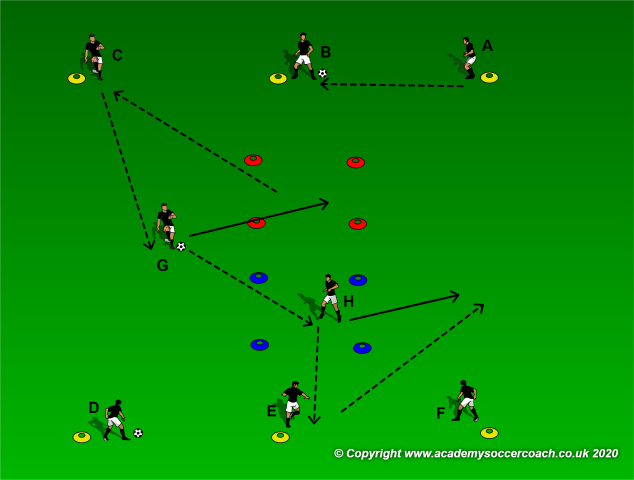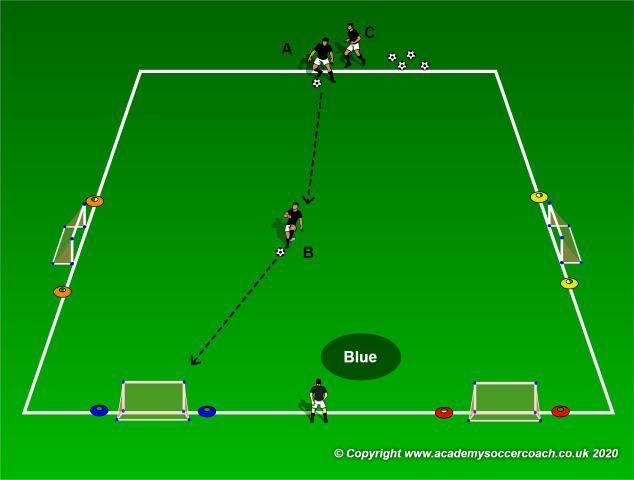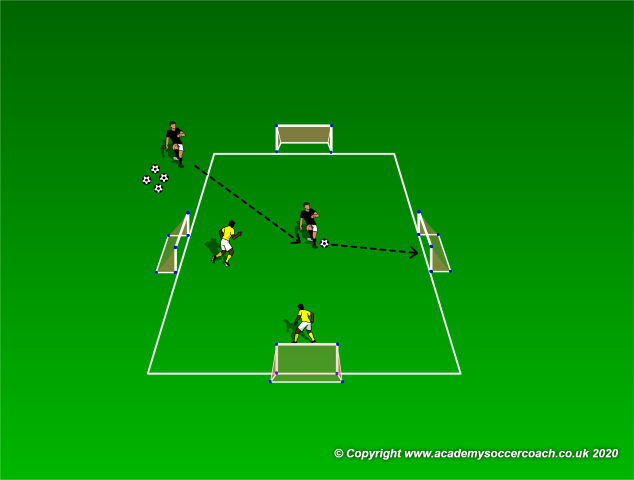By Philip Cauchi
Question - Do you have exercises where I can train "Visual Perception" where the players will be better at scanning the area?
In Parts 1 and 2, I shared some exercises. Here are some more.
Exercise 9: Play to the target player.

Area: 10 yards x 8 yards.
Load: 8 to 10 repetitions of 30 to 40 seconds each with 30 seconds rest in between.
Players: Two target players, one at each end of the area, two midfielders and a defender.
Description: The ball must be played from one target player to another through the midfielders. The receiving midfielder can play directly to the opposite target player or lay the ball off to his teammate for him to play it to the target player. Once the ball reaches a target player, the attackers (blacks) aim to play to the opposite target player. If the defender wins the ball the attackers must not let him pass the ball to the furthest target player.
Progression: Play with a two touch maximum restriction.
Coaching points:
Continuous head movement to look for space and available servers.
Creation of an angle with the passing player.
Stance to receive the ball and the quality of the first touch.
Exercise 10: Dynamic passing combinations.

Area: 20 yards x 15 yards.
Load: 8 to 10 repetitions of 1 minute each with 30 seconds of rest in between.
Players: A group of three players (A, B, C) on one side and another three players (D, E, F) on the opposite side. Two active players (G and H) are positioned in the middle.
Description: Players A, B and C pass the ball to each other, as do D, E and F. Player G receives the ball inside the red area and passes it to any player from A, B and C who doesn’t have the ball. Player G receives the return pass outside the area and passes it to player H inside the blue area. Player H passes the ball to any player from D, E and F who doesn’t have the ball. Player H receives the return pass outside the area. The same sequence is again repeated.
Progressions: Play with a two touch maximum.
Coaching points:
Half turn stance to be able to see who of the three players has the ball.
Creation of an angle with the passing player.
Stance to receive the ball and the quality of the first touch.
Exercise 11: Score in the correct goal.

Area: 12 yards x 12 yards.
Load: 4 to 6 series of 3 to 4 repetitions.
Players: Player B starts without the ball in the middle of the practice area. The other players A and C stand with the ball outside the area. Don’t have more than 4 players waiting in line.
Description: Player A passes the ball to player B. In the meantime the coach calls out a colour that corresponds to the goal player B aims to score into. Repeat three to four times.
Easier variation: Have only two or three mini goals positioned at angles to each other.
Progressions:
1 – Before the ball is played instead of calling a color the coach raises a marker.
2 – Player B receives and wall-passes with player A (at this moment the coach raises the marker) to finish in the correct mini goal.
Coaching points:
Half turn stance to be able to see the color that the coach raises.
Stance to receive the ball and the quality of the first touch.
Exercise 12: Receive to score.

Area: 12 yards x 12 yards with a mini goal positioned on each side line.
Load: 4 to 6 series of 3 to 4 repetitions.
Players: One server outside the area and an attacker and two defenders inside the area.
Description: The server passes to the attacker inside the area to finish on any of the four mini goals. The defenders just intercept the ball being passed into the goal by the attacker. The attacker will be served three or four balls and then switches position with the server. After the assigned number of repetitions are over, the server and attacker switch roles with the defenders.
Progressions:
1 – Attacker must finish within a two touch maximum.
2 – Can the attacker finish all three or four shots successfully within an allocated time limit?
Coaching points:
Movement off-the-ball to receive at an angle.
Stance to receive and finish at goal quickly.
By Philip Cauchi


